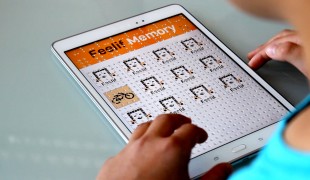- 2546
- 230
- 0
- 0
- 0
- Help Ukraine
About the solution
The professor invented a design which combines the book’s original text with Braille, allowing both sighted and blind people to read the same book at the same time.
Eric and his wife Leslie were frustrated because they wanted to able to read stories with their son. But traditional Braille books are printed in a way that doesn’t make it easy for a sighted person to read along. As the Braille reader’s fingers scan the Braille, the printed words are often covered up. Also some books were Braille-only books with no corresponding words in print, while others had Braille printed on plastic pages that either adhered to the original pages, sometimes covering the text and illustrations, or were bound in separately where the Braille didn’t align with the printed words.
“For Ethan to share books with siblings and friends (like his brother, Spencer), the original illustrations and text needed to remain intact. I basically took the list of problems, and thought, ‘How am I going to solve these?”, the father recalled.
Eric redesigned well-known children’s books so that print and Braille readers could enjoy the same book. This design includes the original text and illustration at the top of each page, and Braille at the bottom with the corresponding print also directly above.
This presents a solution by preventing the Braille reader’s hands from blocking what the sighted reader needs to see, and it enabled a sighted reader to learn Braille basics.
Each book also has a Braille glossary in the back for the alphabet, numbers and punctuation.
Eric presented his idea in a conference, and founded BrailleInk, a non profit organization to design and sell the books with his partner Bruce Curtis.
Adapted from: http://americanprofile.com/articles/brailleink/
More info: http://www.brailleink.org
这些解决方案不应包括使用药物,化学品或生物制品(包括食品);创伤性设备;冒犯性的,商业或内在危险的内容。该解决方案未经医学验证。请谨慎进行!如果您有任何疑问,请咨询健康专家。
DISCLAIMER: This story was written by someone who is not the author of the solution, therefore please be advised that, although it was written with the utmost respect for the innovation and the innovator, there can be some incorrect statements. If you find any errors please contact the patient Innovation team via info@patient-innovation.com
-
-
596
-
2
-
10772

Feelif is a multimedia device for blind and visually impaired people
COMMUNICATION: Communicating, whether by speaking, listening, or other means
Reading
Video gaming
Blindness
Visual Impairment
Congenital Deafness
Hearing Disorders
App (Including when connected with wearable)
Videogame
Educational/Leisure device (book, toy, game...)
Vision problems
Hearing loss or ringing in the ears (tinnitus)
Managing Neurological Disorders
Improving Speech and Communication
General and Family Medicine
Medical Genetics
Neurology
Ophthalmology
Otorhinolaryngology
Pediatrics
Slovenia
-
-
-
328
-
0
-
5213

Girl invents toy to cope with dyslexia
Reading
Writing (letters, songs, peoms)
Studying
dyslexia
Visual Impairment
Hearing Disorders
Educational/Leisure device (book, toy, game...)
Vision problems
Difficulty speaking or understanding speech
Cognitive impairment
Memory loss
Confusion
Managing Neurological Disorders
Improving Speech and Communication
Child and Adolescent Psychiatry
Neurology
Pediatrics
United Kingdom
-
-
-
417
-
0
-
6447

Music to help autistic children
COMMUNICATION: Communicating, whether by speaking, listening, or other means
CAREGIVING
Listening to music
Autism
Podcast
Educational/Leisure device (book, toy, game...)
Social Media
Difficulties with speech
Difficulties learning how to talk
Promoting self-management
Managing Neurological Disorders
Promoting inclusivity and social integration
Improving Speech and Communication
To improve Treatment/Therapy
Raise awareness
Caregiving Support
Child and Adolescent Psychiatry
Neurology
Pediatrics
Psychiatry
United States
-
 zh
zh